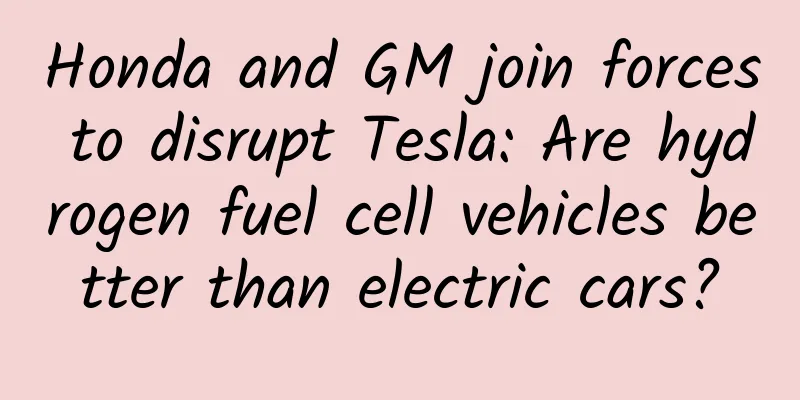Honda and GM join forces to disrupt Tesla: Are hydrogen fuel cell vehicles better than electric cars?

|
Starting from December last year, if you see a car with a green license plate in the five cities of Shanghai, Nanjing, Wuxi, Jinan and Shenzhen, it means that the car is equipped with an electric-powered heart. Driven by various factors such as national policies, there will inevitably be more and more green-licensed cars on the streets. However, is electric the only way for new energy vehicles in the future? Traditional auto giants are giving completely different answers from Tesla. At the beginning of 2017, Honda and General Motors, two well-known automobile manufacturers, announced their cooperation. The two parties will set up a joint venture in the United States to jointly manufacture fuel cell systems. The ultimate goal is to accelerate the development of hydrogen fuel vehicles. Use new energy vehicles the same way as gasoline vehicles Even with star products like Tesla, the development of electric vehicles has not been as smooth as expected. One of the main reasons is that electric motors are far less convenient to use than internal combustion engines. The long charging time means that pure electric vehicles will feel like a replica of smartphones. The price that pure electric vehicle users pay for not having to worry about license plates in big cities is that the car in their hands is likely to drive you crazy on long-distance highways of hundreds of kilometers. Faced with the reality that even Tesla cannot avoid the problem of pushing cars, many car manufacturers have tried to use hybrid electric vehicles as transitional products, and even use the engine to charge the electric motor battery in some cases. In comparison, the hydrogen fuel cell vehicles that Honda and GM are jointly targeting this time can be said to combine the convenience of traditional cars with the environmental protection characteristics of pure electric vehicles. Users can refuel hydrogen fuel cell vehicles like traditional fuel vehicles, and achieve zero emissions like pure electric vehicles, that is, the emissions are clean and pollution-free pure water. It can almost be said to be the most ideal new energy vehicle choice. In addition, compared with pure electric vehicles, the greater advantage of hydrogen fuel vehicles lies in their endurance, which can easily reach about 500 kilometers. If the charging time saved by refueling is taken into account, the overall practicality is quite considerable. What obstacles are there to the development of hydrogen fuel vehicles? Like electric vehicles, the reason why nearly "perfect" hydrogen fuel vehicles have not replaced traditional vehicles on a large scale is that they still face the same popularization difficulties as all new energy vehicles. First of all, since the cost of hydrogen fuel and hydrogen fuel cells is very high, it is not as cost-effective for automobile manufacturers to develop and sell hydrogen fuel vehicles as electric vehicles, resulting in a very limited number of hydrogen fuel vehicles available on the market. In China, perhaps only car enthusiasts can spot Toyota Mirai or Honda Clarity at auto shows. Even if American consumers can actually buy Toyota Mirai, known as the "hydrogen-powered Prius", its price of nearly $60,000 is unlikely to stop people from buying a more luxurious and comfortable BMW 5 Series or Mercedes-Benz E-Class at the same or even lower price in their place of residence. Secondly, hydrogen transportation, storage and safety have higher technical barriers than electricity or traditional fuel, and the relevant technology is not mature enough. Like charging piles and gas stations, the promotion of hydrogen fuel vehicles also requires the construction of a large number of basic supporting facilities in cities. The construction cost of a hydrogen refueling station alone is about 3 million US dollars, which brings huge financial pressure to the road of hydrogen fuel vehicles. However, the biggest problem lies with the hydrogen fuel itself. At present, most hydrogen production is inseparable from oil, relying on fossil fuels to produce "brown hydrogen" in an environmentally unfriendly way; and it is inevitable to use metal platinum as a catalyst in hydrogen fuel cells. If hydrogen fuel vehicles are just traditional fuel vehicles with a "new energy" shell, then they obviously cannot be truly equated with pollution-free. The second cooperation between Japan and the United States may bring about a turning point in the development of new energy vehicles In fact, as early as 1992, the Japanese automobile manufacturer Toyota began research on fuel cells represented by hydrogen power, and since 1997, it has cooperated with the University of California, USA, to build two hydrogen fuel cell vehicles based on the first-generation Toyota Highlander. After more than 20 years, the cooperation between Honda and GM, two automotive giants, symbolizes the second cooperation between the automotive industries of Japan and the United States in the field of hydrogen fuel vehicles. Relevant data also shows that between 2002 and 2015, Honda and GM obtained more than 2,220 fuel cell technology patents in total, which is definitely a positive model for promoting the popularization and development of hydrogen fuel vehicles. It is also worth noting that Japanese automakers, especially Toyota and Honda, which excel in innovative technology, have been the first wave of forces leading the development of electric vehicles and hybrid electric vehicles from the beginning. General Motors' Chevrolet VOLT is also an important role for traditional American automakers to enter the electric vehicle market. The pioneers of the electric vehicle industry have begun to turn to hydrogen fuel vehicles, which naturally means that in the context of the new energy concept, the automotive industry has new opportunities besides electric drive. Of course, it is also obvious that traditional automakers have greater concerns about hydrogen fuel cells than electric vehicles. For example, Toyota, which was the first to get involved in hydrogen fuel cells, expressed its determination to manufacture pure electric vehicles at the end of last year. So, will cars in the future need to consume electricity? Or will they need to consume new energy sources such as hydrogen fuel? It still depends on whether electric cars can quickly seize the market in the future, or whether hydrogen fuel cars can get rid of various drawbacks such as high costs before electric cars are accepted by more people. It is foreseeable that as new technologies gradually reduce the popularity of traditional internal combustion engines, a new round of technological competition among automobile manufacturers in different camps will continue after new energy is injected into automobiles. As a winner of Toutiao's Qingyun Plan and Baijiahao's Bai+ Plan, the 2019 Baidu Digital Author of the Year, the Baijiahao's Most Popular Author in the Technology Field, the 2019 Sogou Technology and Culture Author, and the 2021 Baijiahao Quarterly Influential Creator, he has won many awards, including the 2013 Sohu Best Industry Media Person, the 2015 China New Media Entrepreneurship Competition Beijing Third Place, the 2015 Guangmang Experience Award, the 2015 China New Media Entrepreneurship Competition Finals Third Place, and the 2018 Baidu Dynamic Annual Powerful Celebrity. |
>>: Foxconn says it won't run away, but suspicions persist
Recommend
Experience Meizu Blue Note: A combination of many "firsts"
This year, Meizu launched two new products, MX4 a...
JD.com's Wu Jiali: Only by doing a good job in software and hardware can the value of large screens be realized
On September 22, at the "2017 China OTT Larg...
Measuring wind, clouds and rain, how capable is weather radar?
Author: Haiyueming Studio Weather radar and weath...
Which cancers are related to “eating”?
Pay attention, pay attention! The following 8 typ...
I was aware that I was dreaming and I could even control it...
Dreaming is a confusing, hazy experience that is ...
In-depth information | The most comprehensive guide to Baidu information flow advertising is online
Baidu is one of the three largest traffic giants,...
How to reduce APP uninstall rate? Here are seven ways!
The mobile application market is now a crowded ma...
Stunning and stunning, how are these atmospheric wonders formed?
Produced by: Science Popularization China Author:...
World's first! Surgical robot autonomously performs laparoscopic surgery in pigs
Written by: XT Editor: Kou Jianchao Layout: Li Xu...
Is “Which excavator is the best” a marketing move by Lanxiang?
Recently, Lanxiang has been played to pieces. The...
Have people in Northeast China ever eaten cranberries? | Bolan Daily
Have people from Northeast China ever eaten cranb...
The outdated board game Werewolf is making a comeback, and the APP is very popular, but there are many pain points
The predecessor of Werewolf was a killing game , ...
Crossing your legs, lying like Ge You...how do these bad postures ruin your body?
One minute with the doctor, the postures keep cha...
iQOO 11S review: Supercomputing independent graphics chip + E6 screen + 200W flash charging, powerful for more than just gaming
With the improvement of mobile chip performance, ...
Who invented the concept of virtual age?
At the end of every year, the firecrackers in the...









